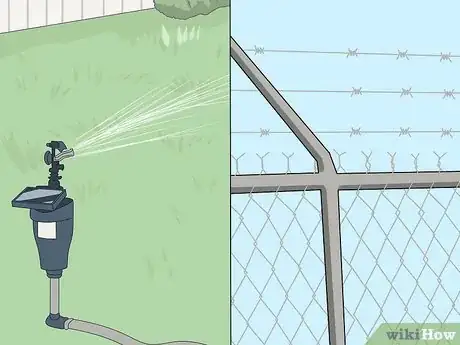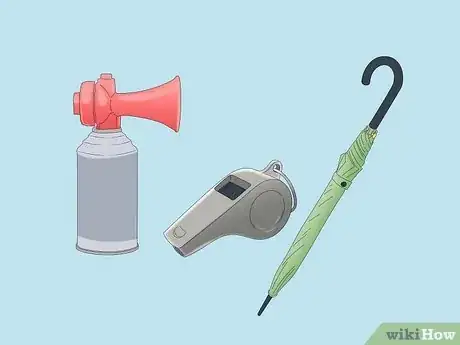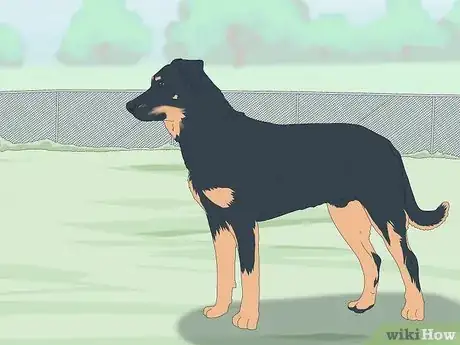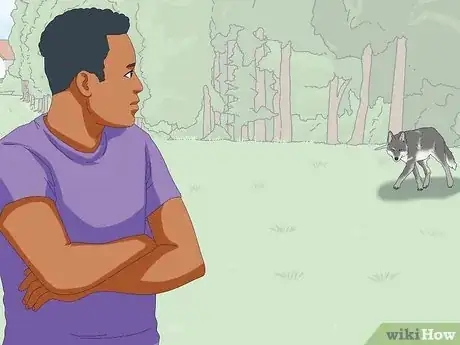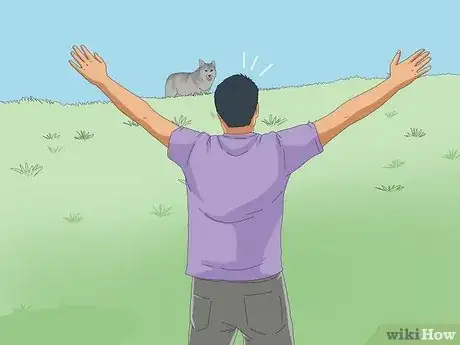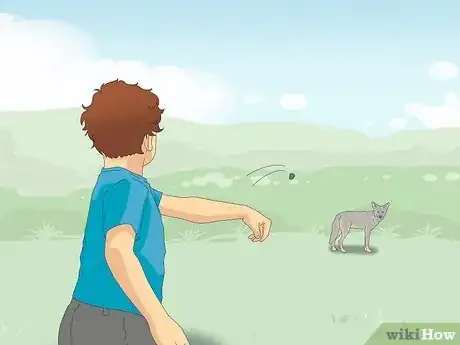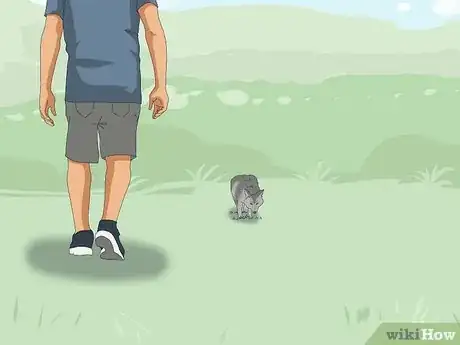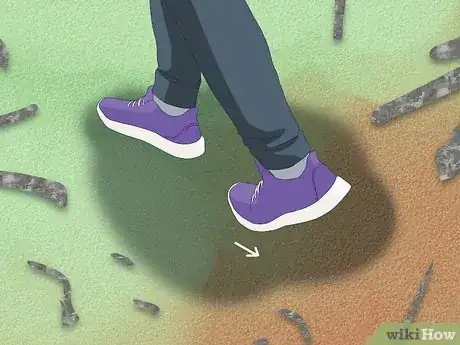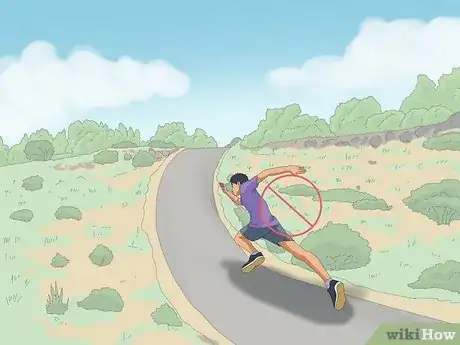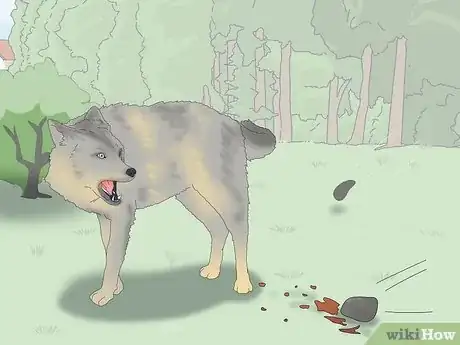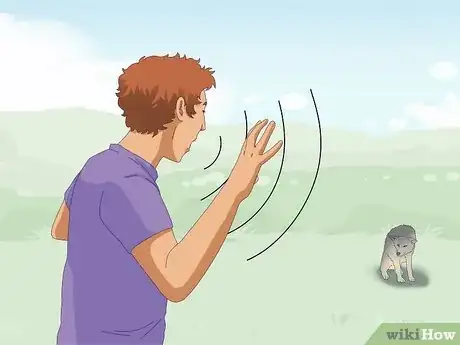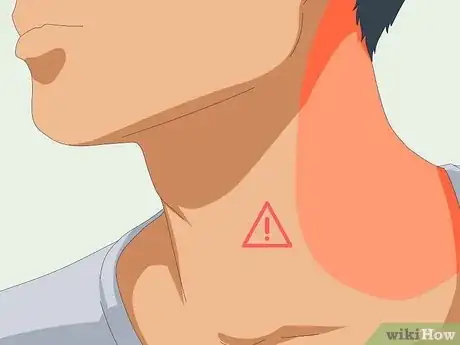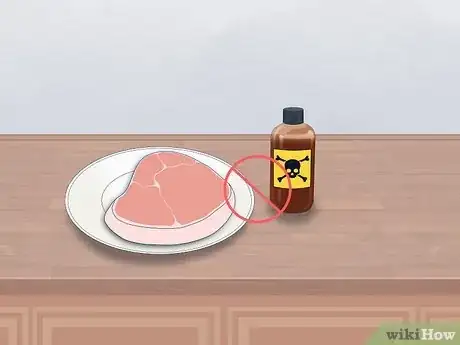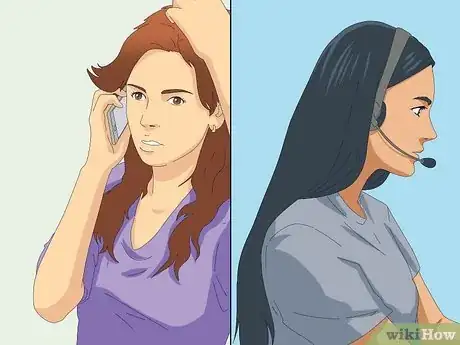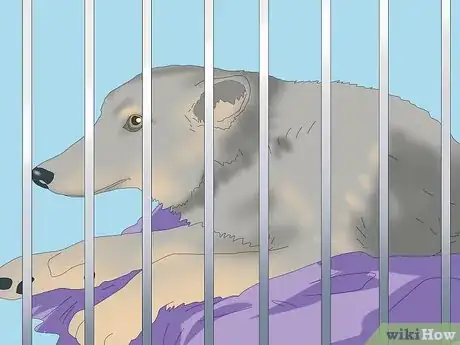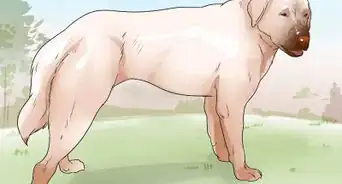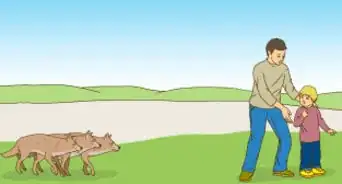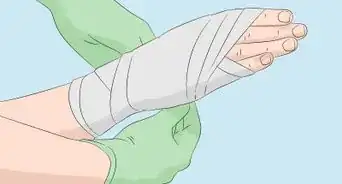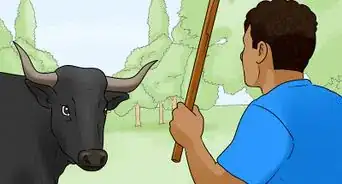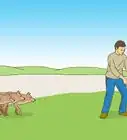wikiHow is a “wiki,” similar to Wikipedia, which means that many of our articles are co-written by multiple authors. To create this article, 39 people, some anonymous, worked to edit and improve it over time.
wikiHow marks an article as reader-approved once it receives enough positive feedback. This article has 14 testimonials from our readers, earning it our reader-approved status.
This article has been viewed 328,398 times.
Learn more...
The coyote is one of the most common and adaptable animals in North America. As a general, coyotes are timid and confine themselves to rural and forested areas, although they can also survive in urban and other populated areas. Coyote attacks against humans are extremely rare and, in fact, there are only two confirmed deaths in Canada and the United States. However, it is possible that you may encounter a coyote in the wild or in your own neighborhood.
Steps
Creating an Unwelcome Environment for Coyotes
-
1Make your environment inhospitable for coyotes. Most coyotes are no longer afraid of humans and there are reports of increased coyote sightings in urban and suburban areas. In other words, a coyote who does not immediately run away when encountering humans has probably become habituated to the presence of people. You can help prevent coyotes from wandering into your neighborhood by attending to the environment in several ways.
- Keep trees and shrubbery neatly trimmed to eliminate hiding places for coyotes.
- Install coyote-proof fences or other motion-triggered deterrents like light or sprinkler systems.[1]
-
2Do not leave food outside of your home or campsite. Humans increase the likelihood of conflicts with coyotes by feeding the animals directly and by giving them access to garbage, pet food and other food remnants.
- Clean up fallen fruit and birdseed from your yard and do not keep any pet food outdoors.
- Secure your garbage and compost bins with rope, chain, bungee cords or weights to keep coyotes from getting in. To prevent tipping, secure the side handles to stakes driven into the ground or keep the bins in a secured shed or garage.[2]
Advertisement -
3Prepare for encounters with coyotes if you frequent their natural habitat. When hiking, bring a large stick or umbrella with you in case of attack. It is also useful to have noisemakers, like air horns and whistles, readily on hand in order to scare off any approaching coyotes. Other options include vessels filled with chemical solutions, such as pepper spray or a vinegar-filled water gun.
-
4Get a Guard Dog. While coyotes love hunting against small dogs, cats, pests such as rodents, and other wildlife animals, they fear large and heavy dogs due to their size, aggression, and strength (though coyotes may attack elderly dogs). A guard dog will protect you, your property, and your family from intruders by fighting them. In this case, the following breeds of dogs make great dogs that will scare coyotes enough to get them to leave your property:
- The Great Pyrenees
- Anatolian Shepherd
- Just to name a few
Encountering a Coyote
-
1Do not approach or frighten a coyote if you see one in the wilderness. Coyotes commonly "shadow" humans passing through their territory to ensure that you don't bother their dens. As long as the animal does not approach, you should just continue with whatever you were doing.
- Escalate your response only if a coyote comes closer. Remember, most coyotes prefer to stay away from large predators, including humans. Avoid turning a harmless sighting into a dangerous encounter by evaluating the situation carefully before undertaking any action.
-
2Engage in "hazing." To haze is to scare the animal away from you. Make yourself look as big, imposing, and aggressive as possible. Wave your arms above your head and shout in a low but loud and authoritative tone in order to frighten the coyote into retreating. Use tools that appeal to multiple sense, including different lights, sounds and motions.
- Stand your ground. Make eye contact and haze until the coyote(s) retreats. Be consistent and assertive in your behaviors and mannerisms and make sure to allow room for the animal(s) to escape.
- Keep the coyote's attention on you as the source of danger and discomfort. Do not haze from buildings or cars because the animal won't be able to see you as clearly. [3]
- Throw objects such as sticks and rocks to make the coyote feel unwelcome and induce it to leave you alone.
- Spray a hose or water gun and make loud noises by banging pots together if you are approached by a coyote in a residential or urban area.
-
3Protect more vulnerable members of your group. Immediately recall and leash your dog or other pets. Shield any children with your body or place them in the center of the group and form a ring around them.
- Educate children about what to if they encounter a coyote on their own at home or in the wild. Instruct them to keep eye contact with the animal and to throw rocks and sticks if cornered and without an adult nearby to assist. Demonstrate and rehearse different situations with the children.[4]
-
4Do not turn your back on the coyote(s) at any point. This indicates submission, weakness and fear; instead, face the coyote to maintain a dominant posture.
Facing and Escaping an Attack
-
1Back away slowly and carefully from the coyote. Do this if your initial efforts to look and sound aggressive do not force the animal to retreat. While moving away, maintain your dominant and powerful stance and keep facing the coyote.
-
2Never run away from a coyote. This increases like likelihood of being attacked. You cannot outrun a coyote. It may go against your gut instinct to not run away, but this is an important preventive measure against a coyote attack.
-
3Throw sticks or clumps of dirt if the coyote becomes aggressive. Coyotes show their aggression by growling or snarling. If you see these behaviors, try throwing sticks or dirt, either at the ground near the coyote or at the coyote itself. Avoid aiming to strike the coyote's head, as this may intensify the animal's aggression.
-
4Continue to be loud and bold. Try again to back away from the animal. De-escalation is the best strategy as an attack looks increasingly possible.
-
5Protect your throat and arteries if the animal attacks you. These areas of the body are vulnerable to serious injury and blood loss through biting.
-
6Avoid harming the animal. Do not use poisons against coyotes as these are inhumane and may also be illegal. Further, they may result in the secondary poisoning of other pets or animals. In addition, do not try to enclose or capture the animal. It is most important that you get yourself (and your group if this is the case) to safety. Further, it is illegal to keep wild animals and domesticate them.
-
7Consult a doctor or other medical professional if attacked. You should especially see a medical professional if you have been bitten so the wound can be assessed and cleaned. In most attacks to date, the coyote was either being fed by people or had bitten an individual while he or she tried to rescue a pet from the coyote. In rare cases, individuals were bitten by cornered coyotes; even more rare are attacks by rabid coyotes.[5]
Following an Encounter with a Coyote
-
1Report any aggressive coyote behavior to the appropriate authorities. If this behavior occurred on your property, consult your local municipality. For encounters in a preserved forest or national park, report to the relevant forestry or parks district.
-
2Keep track of when and where you encounter coyotes. If you encounter them in urban or suburban spaces, share this information with neighbors and your local animal control branch. Coyotes are creatures of habit.[6] Be sure to change your routine if you see a coyote at the same time and place while walking your pet.
-
3Follow up with the health, animal control, or other authorities. Coyotes involved in biting attacks will be targeted and removed from the population. They are then often tested for rabies and are killed if found infected. However, it is important to note that an attack by an individual coyote does not warrant the general killing of coyotes. Recall that coyote attacks on humans are exceptionally rare.[7]
Community Q&A
Did you know you can get answers researched by wikiHow Staff?
Unlock staff-researched answers by supporting wikiHow
-
QuestionDo coyotes come out during the day?
 wikiHow Staff EditorThis answer was written by one of our trained team of researchers who validated it for accuracy and comprehensiveness.
wikiHow Staff EditorThis answer was written by one of our trained team of researchers who validated it for accuracy and comprehensiveness.
Staff Answer wikiHow Staff EditorStaff AnswerWhile coyotes are mainly nocturnal, this does not mean you won't ever see them during the daytime. For starters, both dawn and dusk are still times with some light during which coyotes are likely to be active as part of their nocturnal foraging. And, they may be around during the day for such reasons as needing to move cubs away from danger, needing to escape danger themselves, sating hunger when they caught nothing at night, moving from one location to another (especially if there are territorial disputes) and the like. However, they will be super wary during the daytime, as they know they have little cover if spotted by predators like humans.
wikiHow Staff EditorStaff AnswerWhile coyotes are mainly nocturnal, this does not mean you won't ever see them during the daytime. For starters, both dawn and dusk are still times with some light during which coyotes are likely to be active as part of their nocturnal foraging. And, they may be around during the day for such reasons as needing to move cubs away from danger, needing to escape danger themselves, sating hunger when they caught nothing at night, moving from one location to another (especially if there are territorial disputes) and the like. However, they will be super wary during the daytime, as they know they have little cover if spotted by predators like humans. -
QuestionHow do you keep coyotes away from your home?
 wikiHow Staff EditorThis answer was written by one of our trained team of researchers who validated it for accuracy and comprehensiveness.
wikiHow Staff EditorThis answer was written by one of our trained team of researchers who validated it for accuracy and comprehensiveness.
Staff Answer wikiHow Staff EditorStaff AnswerThe main methods include noise, fences and negative reinforcement, like spraying the coyote with a hose if you see it. Also, keep pets and food sources safe indoors, to discourage coyote visits. You'll find lots of helpful ideas for keeping coyotes away from your home and pets in the wikiHow: How to Keep Coyotes Away from Campsites or Homesteads.
wikiHow Staff EditorStaff AnswerThe main methods include noise, fences and negative reinforcement, like spraying the coyote with a hose if you see it. Also, keep pets and food sources safe indoors, to discourage coyote visits. You'll find lots of helpful ideas for keeping coyotes away from your home and pets in the wikiHow: How to Keep Coyotes Away from Campsites or Homesteads. -
QuestionDo coyotes attack people?
 wikiHow Staff EditorThis answer was written by one of our trained team of researchers who validated it for accuracy and comprehensiveness.
wikiHow Staff EditorThis answer was written by one of our trained team of researchers who validated it for accuracy and comprehensiveness.
Staff Answer wikiHow Staff EditorStaff AnswerCoyote attacks against people have been known to happen but they are rare. In those instances where a coyote has attacked a human being, there have been only 2 deaths confirmed from this in Canada and the United States. The coyote is wary of humans; it knows humans as strong, big, diurnal hunting creatures and it knows that it is not a good match should it attack a human. The most likely reason for an attack would be if you were to threaten its cubs or its own life. Your pets, on the other hand, are at great risk should a coyote come close to cats or dogs.
wikiHow Staff EditorStaff AnswerCoyote attacks against people have been known to happen but they are rare. In those instances where a coyote has attacked a human being, there have been only 2 deaths confirmed from this in Canada and the United States. The coyote is wary of humans; it knows humans as strong, big, diurnal hunting creatures and it knows that it is not a good match should it attack a human. The most likely reason for an attack would be if you were to threaten its cubs or its own life. Your pets, on the other hand, are at great risk should a coyote come close to cats or dogs.
References
- ↑ http://dupageforest.com/Education/Education_Centers/Willowbrook/Living_With_Wildlife_in_DuPage_County/Coyotes.aspx
- ↑ http://wdfw.wa.gov/living/coyotes.html#problems
- ↑ http://www.projectcoyote.org/
- ↑ http://wdfw.wa.gov/living/coyotes.html#problems
- ↑ http://www.humanesociety.org/animals/coyotes/tips/coyotes_people.html
- ↑ http://www.projectcoyote.org/
- ↑ http://www.humanesociety.org/animals/coyotes/tips/coyotes_people.html
About This Article
To survive a coyote attack, try to make yourself appear as big and loud as possible to scare the coyote away. Never run away from a coyote since you won't be able to outrun it and it will make the coyote chase you. Instead, back away slowly and carefully while maintaining eye contact with the coyote. If it attacks you or becomes aggressive, try to throw rocks, sticks, or clumps of dirt at it to scare it off. Also, if the coyote lunges at you, protect your throat and arteries since these areas are the most vulnerable if bitten. To learn how to avoid a coyote attack, keep reading!
